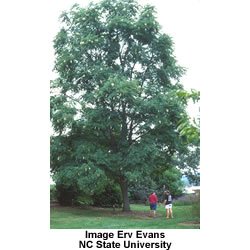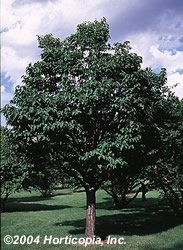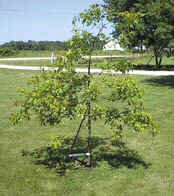

 Kentucky Coffee Tree The Kentucky Coffee Tree, Gymnocladus Dioicus, may also be known as American coffee berry, Kentucky mahogony, nicker treet, or stump tree. Kentucky Coffee trees are large round-barked trees belonging to the legume family and reaches heights of 60 to 100 feet. Its short trunk, 1 to 2 feet in diameter, divides into several large branches. The leaves are ovalish and are 2-4 inches long. An unofficial state tree of Kentucky, the Kentucky Coffee Tree is closely related to the honeylocust. This deciduous tree is ideal as a shade tree on larger, ungroomed properties. It got its name because early North American colonists used the large seeds to make coffee. When eaten raw, the seeds are poisonous. The bark is deeply furrowed and dark brown in colour. It adapts well to urban conditions. Fall color is yellow turning to orange.
|
Mimosa Tree The Mimosa tree, Albizzia julibrissin, sometimes called Silk tree, was introduced to the United States in 1745 for use as an ornamental plant because of its unusual, attractive and fragrant pom-pom like flowers and interesting fern-like foliage.This deciduous tree is attractive to bees, butterflies, and birds. In gardens this tree grows to 20–30'. Mimosa trees are fast-growing but rather short-lived. It has a single trunk with smooth gray bark. Each bipinnate leaf is made up of hundreds of tiny leaflets coated in white hairs, giving the foliage a silvery cast. In late winter or spring the domed crown is decked in sprays of small, globular, golden yellow flower heads. It is able to survive winter in southern U.S., but flowers better in climates with a longer, drier summer.
|
|
Sargents Crabtree The Sargent Crabapple tree, Malus Sargentii, is a dwarf flowering tree that flowers profusely in early spring with pink to white scented blossoms. Excellent for wildlife because of its edible dark red berries. Summer foliage is a dark green color. It is used as a specimen or patio tree. This deciduous tree has moderate water requirements and a moderate tolerance to salt and alkali. One of the smallest crabapples, it is a mounded, wide spreading tree, (wider than high), with disordered branching and frequent cross branching. Flowers are white, red when bud is opening. The fruit is bright red. This crabapple has the smallest leaves of all the crabs. Sargent Crabapple trees are know for their stunning flowers.
|
Sassafras Tree The Sassafras tree, Sassafrax variifolium, also known as the Sassafrac, Saxifrac, Smelling Stick, Aguetree, and Cinnamonwood tree. This widespread Eastern U.S. native is ideal for naturalistic landscaping. Sassafras is a native tree, growing in rich woods from southern Maine to Ontario, Michigan, and Kansas and south to Florida and Texas. The sassafras occurs in the North as a shrub, but in the Southern States it sometimes attains a height of 100 feet. This deciduous tree has leaves that are shaped like a mitten. The yellowish green, fragrant flowers are borne in clusters which appear in early spring. The fruit, which ripens in September, is about the size of a pea. All parts of the tree are aromatic. The bark of the root, which is in reasonably constant demand is collected in spring or autumn. The production of sassafras oil by distillation of the root and root bark is a small industry in the southeastern section of the country. Leaves are a medium green and turn orange, red, or yellow in fall.
|
|
Root Feeder Tree Cartridges About the Root Feeder Tree Cartridges: The tree cartridges are made up of a 25 10 10 formula. The cartridges are to be used with our Professional Root Feeder.
|
 Tree Lilac The Tree Lilac, Syringa reticulata, 'Ivory Silk' is a heavily flowering tree, covered by large plumes of small white flowers in the beginning of summer. Its dark green leaves blending with the fragrant white flowers are a favorite for spring-time landscapes. This small deciduous tree has recently attracted the interest of urban foresters as a small tree for planting under power lines. The leaves are similar to the common lilac shrub, dark green and oppositely attached to a shiny brown, stout stem. The Japanese tree lilac is very hardy and able to withstand winter temperatures as low as 30 degrees below zero. The Ivory Silk Tree Lilac is useful as a specimen or a street tree, as well as in a group, screen, or windbreak. It flowers more heavily than other lilac species. Ivory Silk is probably the most trouble free and tough lilac that is available.
|
 Tree Trainer About the Tree Trainer: The trainer is made of a rust-resistant aluminum bar, rings, UV treated straps, and neoprene pad.
|

Join "Garden Notes" and plan for Harvest Success as you track and record your gardening progress. Your Free Personal Garden Journal has pages for jotting down notes on the seeds you start, your new plantings, when you fertilized, and even a graph to plot a new garden.
I didn't want to see another internet "eBook" on growing anything, but my husband signed up for Kacper's free report and I have to tell you, it is WELL worth the read. If you think you know everything about growing tomatoes, I challenge you to read Kacper's report. HIGHLY recommended!

Based entirely on organic gardening principles. This says it all. Joy's book has been fully revised and updated and includes extensive new reading, particularly on oriental and fruiting vegetables, and did I mention, is now entirely based on organic gardening practices. Read More...
